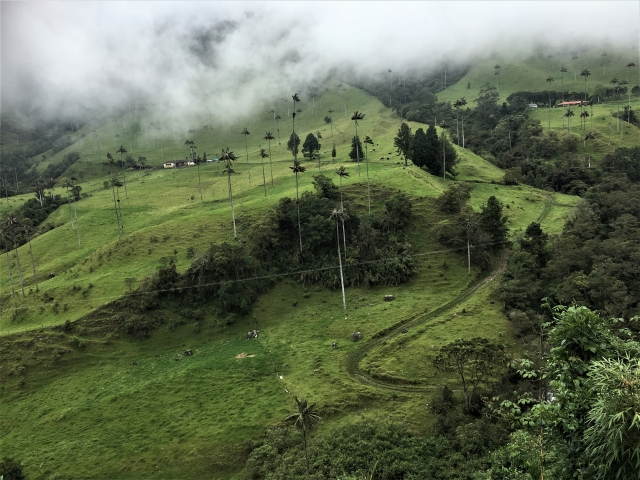
Hello, colorful beans. I’d be happy to explain the history, cultivation environment, and characteristics of Colombian coffee.
The history of Colombian coffee
First, let’s confirm the location – South America is Brazil’s neighbor.


Brazil is a representative coffee-producing country, and Colombia is its neighboring country. Nowadays, Colombia is one of the world’s leading coffee-producing countries, but its origin dates back to the 18th century.
Coffee trees planted in the Santa Teresa Christian monastery around 1730 are considered the origin. By the mid-1800s, coffee cultivation was already taking place in the interior of the country in Santander.
However, Colombia was far behind other Latin American countries such as Brazil. As demand for coffee increased, cultivation began to spread beyond Santander. Since it couldn’t compete with Brazil in terms of production volume, Colombia decided to incorporate Costa Rica’s coffee production policies.
“They set a goal of producing higher quality coffee than Costa Rica and at a higher volume than Costa Rica.”
“This is a personal opinion, but although they tried to imitate Costa Rican coffee production methods, they were unable to match the quality of Costa Rican coffee varieties. It seems that they were able to win in terms of production volume.”
In the 19th century, the coffee industry expanded, and in the 20th century, Colombian coffee beans became highly valued internationally. There were frequent improvements in variety through breeding as well, resulting in the creation of the ‘Colombia’ variety.
Fun fact: If we consider only the arabica variety processed by the wet method, Colombia produces the highest amount in the world.
The environment of Colombia.
Colombia is located directly on the equator and is blessed with a mountainous terrain, abundant water sources, and diverse climatic zones, making it an ideal environment for coffee cultivation.
Colombian coffee is grown in high-altitude, long-sunshine-hour mountainous areas. Due to the slower growth rate of the beans at higher altitudes, the unique acidity and aromatic components of coffee beans are more pronounced, resulting in a rich, flavorful taste.
Additionally, Colombia is blessed with abundant water sources such as the Pacific Ocean, the Caribbean Sea, the Amazon River, and the Andes Mountains, which ensure that the water needed for coffee cultivation is readily available.

Emerald Mountain
You may recognize the brand of Colombian coffee beans called “Emerald Mountain,” which has become widely popular along with the more well-known Colombian Supremo. It can be said that the Emerald Mountain brand was born as Colombian farmers attempted to imitate the quality of Costa Rican coffee beans.
To ensure the quality of their coffee, the Colombian Coffee Growers Federation (FNC) was established in 1927. This organization is responsible for quality control throughout the production and distribution of Colombian coffee.
Through these efforts, the industry was able to develop into a national enterprise that could generate significant profits.
The characteristics of Colombian coffee
Colombian coffee is a type of coffee that elicits various expressions.
It is a bean that tends to divide opinions. In my opinion, it has a mild and easy-to-drink taste.
It could be described as having an American taste, with a well-balanced flavor that is not too bitter or acidic. As for the aroma, it is not very strong and has just a slight fragrance.
Therefore, I feel that it is very difficult to roast this coffee in a way that imparts a distinct flavor.
Colombian coffee is a bean that is known for its mild and easy-to-drink flavor, which some say is too mild. It can be difficult for roasters to give it a distinctive flavor because of this.
Some people describe the coffee as having a chocolate aroma, while others detect fruity notes, such as strawberry jam. Ultimately, the expression of the coffee varies depending on the individual handling it.
The taste of Colombian coffee can be described as very mellow with a sweet flavor. It has a soft acidity, strong body, nutty flavor, and chocolate notes.
Some varieties have a fruity and herbaceous aroma, while others have a strong acidity, medium body, and citrus flavors. There are many different expressions of Colombian coffee and there is no right or wrong one, nor is there a single “best” flavor.
The flavor can vary depending on the roaster and the drinker, and even the same coffee can have different impressions on different days.
These characteristics may be attributed to the power of nature brought about by the Andes Mountains.
The Andes Mountains, being a hilly region, have different rainy and dry seasons depending on the area, allowing coffee harvesting to take place throughout the year.
This results in the different characteristics of the three cultivation regions: the northern, central, and southern parts of Colombia.
Afterword.
What kind of Colombian coffee do you prefer? A cup of coffee that we casually drink every day. By knowing about the country, farm, producer, refining method, variety, etc., the taste that we experience will bring us a new flavor.
Thank you for reading this far.




コメント